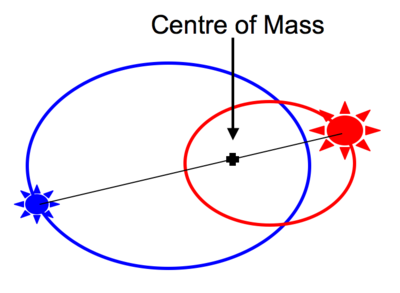Binary Star
In astronomy, a binary system is one that consists of two stars that are gravitationally bound. The two stars obey Kepler’s laws of motion, and orbit their common centre of mass in elliptical or circular orbits. Some relativistic systems, such as the binary pulsars, exhibit behaviour that can only be explained by using Einstein’s General theory of relativity.
Astronomer’s observations of binaries have been pivotal in our understanding of the masses of the stars.
Binaries consist of several sub-types:
Visual Binaries
In a visual binary, both stars are resolved from Earth and can be seen to orbit each other with a given binary period.
Single-lined spectroscopic binaries have characteristic emission or absorption lines that enable astronomers to characterise their orbits using the mass function. In these systems the spectrum is dominated by one of the two stars. Spectroscopic binary systems are usually detected due to the movement of the emission and absorption lines in the observed spectrum, caused by the Doppler effect as the stars move in their orbit.
Dual-line spectroscopic binaries can have spectroscopic features from both stars identified and followed around the orbit. These binaries allow determination of their mass ratio.
Astrometric Binaries
These stars have the presence of a binary companion deduced by their motion across the sky after accounting for proper motion and parallax.
Eclipsing Binaries
Eclipsing binaries suffer changes in their total luminosity due to the blockage of our line of sight to one or both of the stars. This allows deductions to be made about their orbital inclination, which must be nearly edge-on for the eclipse to occur. When combined with radial velocity curves and the mass function powerful constraints on the masses of the stellar components can be obtained.
Study Astronomy Online at Swinburne University
All material is © Swinburne University of Technology except where indicated.


